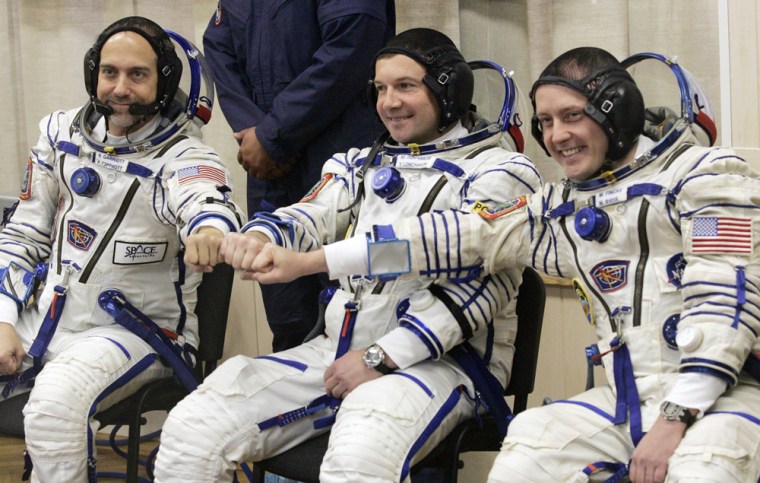A Soyuz spacecraft with two Americans and a Russian on board lifted off from Kazakhstan on Sunday for the international space station.
The Soyuz TMA-13 capsule carrying American computer game millionaire Richard Garriott soared into a clear sky atop a Russian rocket as the latest paying space traveler's family watched from a viewing platform. Also aboard were U.S. astronaut Michael Fincke and Russian cosmonaut Yuri Lonchakov.
The rocket lifted off on schedule at 1:01 p.m. (3:01 a.m. EDT), sending an orange flare behind it as it streaked upward. The craft entered orbit about 10 minutes later.
"I'm elated, elated," said Richard Garriott's father, Owen, a former U.S. astronaut who is the first American to see his child follow in his footsteps and reach space. "They're in orbit, that's good."
Garriott's mother Eve and his girlfriend, Kelly Miller, shed tears of joy and relief at the successful launch.
"This is cool, this is cool," Miller said.
Second-generation space traveler
The Soyuz is to dock Tuesday with the international space station, where Garriott will spend about 10 days conducting experiments — including some whose sponsors helped fund his trip — and photographing Earth to measure changes since his father snapped pictures from the U.S. station Skylab in 1973.
He is to return to Earth in a Soyuz capsule with cosmonaut Yuri Volkov, whose father also traveled to space — making him the first second-generation space traveler.
Garriott, a Texan who made his fortune designing computer fantasy games, dreamed of space as a child but learned as a youth that he could not become a NASA astronaut because of his poor eyesight. He paid a reported US$30 million for his voyage.
"I'm really happy for him. It's one of the things he's wanted to do most in his life. I spent a lot of time listening to him about when he goes up in space," Miller said.
"He's like a kid in a candy shop," she said. "And I already want him to come back."
Garriott, 47, is a board member and investor in Space Adventures Ltd., a U.S.-based company that has organized flights aboard Russian craft for five other millionaires including the first paying space tourist, California businessman Dennis Tito, in 2001.
The most recent paying traveler, billionaire American software engineer Charles Simonyi, also watched the launch and drank champagne with Garriott's family after the craft reached orbit.
Also on hand was Yi So-yeon, a bioengineer who became South Korea's first astronaut when she traveled to the space station last spring.
Yi and two crew mates had a rough ride back to Earth when their capsule failed to separate on time, sending it into a steep trajectory and subjecting them to powerful gravitational forces in a so-called "ballistic" descent — the second straight and the third since 2003.
Playing down concerns
The chief of Russia's space agency Roskosmos, Anatoly Perminov, pledged Saturday that a ballistic landing would not be repeated, and Yi played down any concerns.
"We already had a lot of training for ballistic re-entry, so it's not a big deal," she said, adding that she felt "lucky" to be one of the few people who have had the experience.
"I guess if he also has a ballistic landing, he will feel lucky because he will also be a member of the ballistic landing club," she said.
Perminov said Saturday that increasingly strained ties between Moscow and Washington will not stand in the way of further space exploration. Soyuz rockets and capsules will be the only way to put people on the space station after the U.S. space shuttle fleet is retired in 2010.
Perminov said recent U.S. congressional decisions on future collaboration and the presence of U.S. astronauts at the launch site in Kazakhstan showed that politics would not block cooperation. Congress earlier this month gave NASA permission to purchase seats on Soyuz capsules after 2010.
